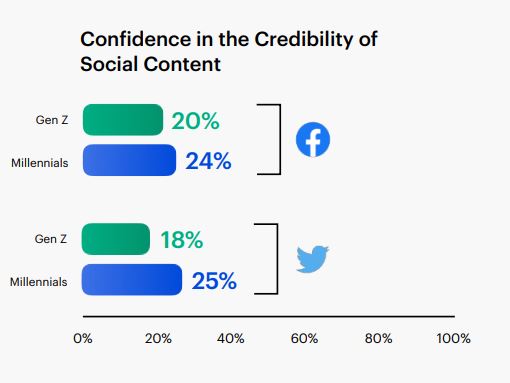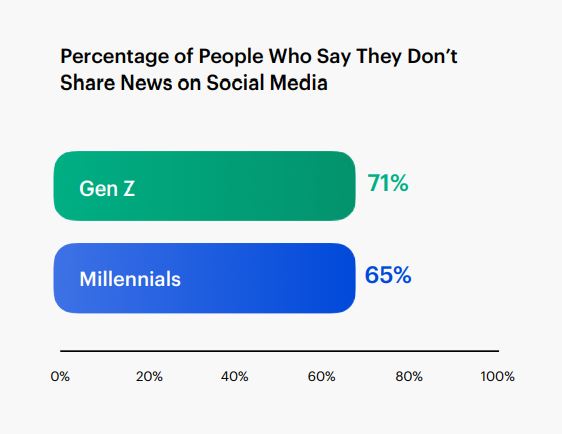Gen Z and millennials (GZM) are often considered jaded, distrustful, and skeptical. And, hey, understandably so.
Collectively born between 1981 and 2012, GZM’s formative years have been marked by the aftermath of 9/11, privacy and data breaches across the web, fake news scandals on social media, government corruption, natural disasters spurred by climate change, and, of course, a global pandemic.
Who wouldn’t be a bit wary? As Pew Research Center found, 60% of young Americans say most people can’t be trusted; they’re also less likely than older generations to have confidence in religious and business leaders, law enforcement, and even school principals. Morning Consult also reported that Gen Z’s trust in governmental institutions plummeted due to the pandemic.
Despite this doom and gloom, there is a positive takeaway here. According to Jeeng’s 2021 Digital Publishing Consumer Survey, GZM internet users actually do trust publishers, and turn to them frequently for important news stories. That’s a big deal coming from these digital natives who are otherwise seen as heavy social media users.

So, what do publishers need to know about GZM’s feelings towards them? And how can they use this information to build on that trust, develop one-to-one relationships, and deliver better experiences for young consumers?
Let’s take a look.
2 in 3 GZM users get their news from publisher sites
Yes, GZM users largely visit social media sites to get their news — 84% of Gen Z and 79% of millennials, specifically. But we were surprised to find that nearly 2 out of 3 GZM also use publishers’ websites for accessing news stories. In fact, 71% of Gen Z and 65% of millennials read 2-3 publications or websites on a regular basis.
These numbers could increase, too, as GZM users steer away from social platforms. According to the Deloitte Global Millennial Survey, roughly 64% of GZM users say they would be physically healthier if they used social media less often and 60% say they would be happier. What’s more, over half of survey respondents believe social media causes more harm than good and 40% hope to stop using it altogether.
1 in 3 GZM users say publisher sites are their primary news source
Move over, social media. One-third of GZM users actually rely on publisher websites as their primary source of news. They’re even more likely than Gen X and Baby Boomers (aged 40-75) to do so.
As Jeeng’s study found, 56% of Gen X and 53% of Baby Boomers rely heavily on publisher websites while 61% of Gen Z and 60% of millennials say the same. Of course, some of this gap can be attributed to GZM’s greater internet usage overall. Still, it’s certainly worth noting that a generation of users known for having their heads in their smartphones aren’t just using those devices for scrolling their social feeds — they’re also visiting web pages for informative content.

GZM users trust publisher content more than social content
Here we go, back to the ever-important “t” word: trust. While GZM users still frequent social media channels, they’re far more confident in the credibility of content on publisher websites. In fact, a whopping 95% of GZM users said they believe the news they read on those sites is credible.
Now compare that with how they feel about social platforms:
- Nearly half of Gen Z and 40% of millennials aren’t confident in the credibility of Facebook content at all or they just don’t use the social platform to begin with.
- Less than 25% of GZM are confident in the credibility of news content on Twitter.
- Only 20% of Gen Z and 24% of millennials are extremely or very confident in the credibility of news they read on Facebook.

We even found that 71% of Gen Z and 65% of millennials don’t share news on social media at all, plausibly due to those credibility concerns. These GZM users indicated that they’re likely to fact-social media news stories for bias before posting, such as by tracing them back to reputable origins and cross-checking information. Really, they must be asking themselves: Why go through the hassle? It’s easier to just head to a publisher’s website and find the story at its source.

Want to see more stats from the 2021 Consumer Survey Report? Check out the infographic below:
What this data means for publishers
Publishers have a valuable opportunity to build on this trust from GZM users and use high-engagement channels to nurture one-to-one relationships with them. Perhaps even more importantly, publishers must learn to diversify their marketing channels, moving beyond just social media and reaching GZM consumers with organic content and owned channels.
Email, for example, is a direct-to-consumer platform that consumers still rely on to get customized content from their favorite publishers and brands. It’s also becoming increasingly important as a hub for collecting first-party audience data, since third-party cookies are being phased out. By reaching GZM on email, publishers can continue to earn that trust and provide real-time value to subscribers.
Investing in building trust with GZM consumers can also drive revenue. For instance, publishers can launch native ads on their websites, in email newsletters, and via push notifications — monetizing these engaged audiences and delivering even more in-depth, personalized experiences along with advertising partners.
Trust Jeeng to help you build trust
That’s where Jeeng comes in. We help publishers build and retain their audiences with data-backed, automated, and relevant content distribution across channels. So whether you’re trying to reach GZM, Gen X, Baby Boomers, or all of the above, we have the tools to make it happen. We can also help you monetize that content with built-in, programmatic ad placements that sync seamlessly with the user experience, allowing you to keep driving revenue and engagement.
Basically, it’s time to start looking beyond the confines of social media and start building the most valuable asset you can own as a publisher: your audience.
Ready to get going? We’re ready to help. Contact us today to learn more.


